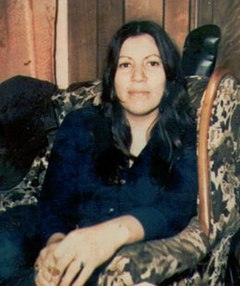Annie Mae Aquash | |
|---|---|
| Naguset Eask | |
 | |
| Born | March 27, 1945 |
| Died | Mid-December 1975.[1][2] (age 30) [Date was initially wrong, and then disputed, until testimony at murder trial made details public.] Body found along Highway 73 at Wanblee in the Pine Ridge Indian Reservation, South Dakota, February 1976 |
| Known for | Activism with the American Indian Movement |
Annie Mae Aquash (Mi'kmaq name Naguset Eask) (March 27, 1945 – mid-December 1975 [1][2]) was a First Nations activist and Mi'kmaq tribal member from Nova Scotia, Canada. Aquash moved to Boston in the 1960s and joined other First Nations and Indigenous Americans focused on education and resistance, and police brutality against urban Indigenous peoples. She was part of the American Indian Movement, participated in several occupations, and participated in the 1973 Wounded Knee incident at the Pine Ridge Indian Reservation, United States.
Aquash also participated in the 1972 Trail of Broken Treaties and occupation of the Department of Interior headquarters in Washington, DC. In the following years, Aquash was active in protests to draw positive government action and acknowledgement of First Nations and Native American civil rights in Canada and Wisconsin. After Aquash disappeared in late December 1975, there were rumors she had been killed. An FBI report by Special Agent David Price states an informant saw Aquash alive on February 12, 1976.[3]
On February 24, Aquash's body was found in Wanblee on the Pine Ridge Indian Reservation in South Dakota; she initially was determined to have died from exposure by a Bureau of Indian Affairs medical examiner, but after a second autopsy two weeks later, was found to have been murdered by an execution-style gunshot wound to the head. Initially, her death was covered up and the body declared to be "unidentifiable". Aquash's corpse was photographed by FBI agent Price. As detailed in In the Spirit of Crazy Horse, the FBI and CIA had previously disseminated rumours that she had been an informant.[4][5] During the trial of John Graham, Candy Hamilton testified that Aquash told her that agent Price had threatened that "he would see that she died" if she didn't cooperate with his investigation of the Pine Ridge shootings of two FBI agents.[6] Leonard Peltier since stated, "I must remind you, it is court record that the FBI lied to extradite me back to the US. I know that their behavior hasn't changed just as I know that Anna Mae was not an informant."[7] Aquash was thirty years old at the time of her death and had two young daughters, Debbie and Denise.[8]
After decades of investigation and the hearing of testimony by three federal grand juries, in March 2003, Arlo Looking Cloud and John Graham (also known as John Boy Patton) were indicted for the murder of Aquash. Looking Cloud was convicted in 2004 and Graham in 2010; both received life sentences.[1] Thelma Rios was indicted along with John Graham, but she pleaded guilty to charges as an accessory to the kidnapping.[9] In 2008 Vine Richard "Dick" Marshall was charged with aiding the murder, but was acquitted of providing the gun. Numerous Aquash supporters and her daughters believe that higher-level AIM officials ordered her murder, fearing she was an FBI informant.
- ^ a b c Lee, Stephen (March 2, 2015). "Jackley: Aquash case might help solve other cold cases from Wounded Knee". Capital Journal. Retrieved June 25, 2021.
John Graham is in prison for life for murdering Annie Mae Aquash in December 1975 on the Pine Ridge Indian Reservation
- ^ a b Maloney, Denise Pictou (December 15, 2012). "Blind Justice". News From Indian Country. Archived from the original on June 25, 2021. Retrieved June 25, 2021.
Annie Mae Pictou Aquash (Mi'kmaq) Naguset Eask - Sun Woman: March 27, 1945 - December 12, 1975
- ^ "Richard Marshall indicted in AIM slaying of Aquash". Lakota Country Times. August 28, 2008. Retrieved February 16, 2021.
- ^ "Leonard Peltier Regarding the Anna Mae Pictou Aquash Investigation (1999-2007)". An Archive. August 26, 2020. Retrieved June 20, 2024.
- ^ Matthiessen, Peter (1992). In the Spirit of Crazy Horse: The Story of Leonard Peltier and the FBI's War on the American Indian Movement. Penguin Books. ISBN 9781101663172.
- ^ "Witness testifies FBI agent threatened Aquash's life". December 3, 2010. Retrieved June 1, 2022.
- ^ "John Graham Defense Committee - News - Peltier". www.grahamdefense.org. Retrieved May 24, 2023.
- ^ "Indigenous Women for Justice web page". Archived from the original on March 15, 2018. Retrieved January 18, 2006.
- ^ "Thelma Rios, who pleaded guilty for role in Aquash murder, dies". Indianz. Retrieved June 20, 2024.